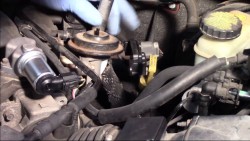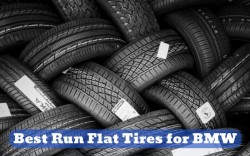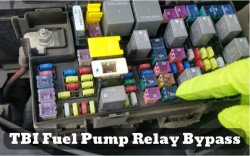How do you test hydraulic brakes for leaks?
Hydraulic brakes are used for modern cars which cover all passenger cars. Now the question is, “how do you test hydraulic brakes for leaks?” An understanding of this will help you identify any problem with your brakes beforehand, you can then contact a professional to fix the problem before any severe damage is done.
How does a brake fluid work?
The hydraulic brake system contains a fluid that is essential in braking. When you push on your brake pedal, the brake fluid transmits the required pressure to the braking mechanism of each tire to cause friction.
A fluid is used because any pressure exerted on it is evenly distributed and undiminished and also because it is non-compressible. With this quality, you have equal pressure distributed to all four tires to cause a car to stop moving.
What causes hydraulic brake leaks?
The hydraulic brake fluid can be classified as one of the most vital fluids in your car system and when it starts to leak, you know that there is a problem coming. Here are some of the common causes of a fluid leak in your car.
Failed piston seal
Some braking component like the disc caliper, master cylinder, or drum brake cylinder only functions with the help of the piston. This is because the piston works by the force transmitted by the fluid and there is a seal that contains the fluid, when the seal breaks, there is a leak which makes the fluid unable to supply the needed force to the piston.
Damaged brake master cylinder reservoir
The brake master cylinder is made of plastic which on exposure to heat could leak out some fluid. The leaked fluid runs down the back of the engine and pools down beneath your car.
Worn out brake pads, rotors, shoes, and drums
The brake pads work with the rotor system to cause friction and stop your car from moving, this applies to a disc brake. And if you are using brakes with the drum system, the brake shoes push against the drums to cause friction.
When these parts wear off, the caliper piston or wheel cylinder becomes hyperextended and this breaks the seal which in turn leaks fluid.
Broken brake lines or brake hose
These brake components are designed and made to be resistant to harsh weather conditions and other external factors, but they start to rust with time. This leads to the brake hose or line breaking which can cause a fluid leak.
Damaged bleeder valve
The brake drums or caliper have a bleeder valve that allows air to be pushed out from the steel brake lines. If this bleeder valve gets damaged or even if it becomes loose, it can lead to the brake fluid leaking out.
How do you test hydraulic brakes for leaks?
A proper inspection is one good way of diagnosing the problem before observing any symptoms, but how do you test hydraulic brakes for leaks?. Fortunately, testing the brakes takes a short time and it's easy to carry out.
You need to pump the brake pedal three times, and then apply a solid pressure to the pedal and then hold your foot in this position for about 5 seconds. The pedal should not move with our foot in this position, if it does then it means that you have a hydraulic leak. You should get your car inspected after this test as a hydraulic leak may not be the cause of the response, but rather other problems with your vehicle.
Symptoms of hydraulic brake leak
Like every other car problem, you also get some unusual behavior from your car if there is a hydraulic leak. Below are some of the symptoms you are likely to notice when you have a hydraulic brake leak.
Check engine light warning
Your check engine light indicates various car problems and a brake fluid leak just happens to be one of them. When this problem is present it triggers the check engine light to flash you a warning. You can also get this notification for other brake-related problems like low brake fluid, the parking brake is activated, a problem with the ABS module, or defective sensors in the parking brake or master cylinder.
A pool of fluid beneath your car
This may just be the most obvious sign of a hydraulic fluid leak. If you notice a clear, yellow, or dark brown color, then you may have a hydraulic leak. However, a puddle under your car does not always mean you have a brake fluid leak, other fluids can also leak and pool beneath your car. When the coolant leaks, you will notice a puddle of greenish fluid, for a transmission fluid you see a pink or red liquid, and then if your engine oil leaks, you can see a golden or brown fluid.
Another accurate way to read a fluid leak is by observing the location of the leak. If the brake caliper leaks, you will see the fluid close to the tires but if the master cylinder or brake line leaks, then you will notice it at the front or rear of your car.
A squishy feeling when you push the brake pedal
When you press your brake pedal, you should feel some resistance, but if you get a soft feeling instead it could signify a problem with the master cylinder, brake booster, or a low level of fluid as a result of a brake fluid leak.
You can pump the pedal several times to see if it builds up some pressure, but if it doesn’t, then you have a brake leak.
The brake pedal drops to the floor
When this occurs it signifies a massive problem with the master cylinder or a major fluid leak. If this happens while driving, make a stop in a safe place using your gear brakes. Contact a certified mechanic to make repairs before using your car on the road.
Conclusion
How do you test hydraulic brakes for leaks? You do this by pushing and holding your foot on the pedal for a while. Driving with a hydraulic leak is dangerous as you will have a problem slowing down your car, and this can cause a major road accident.
We have explained the causes and symptoms of a brake fluid leak, so you can identify the problem and get the car fixed before driving it. Make sure you contact a certified mechanic to make the repairs and do not ignore any puddle under your car.




